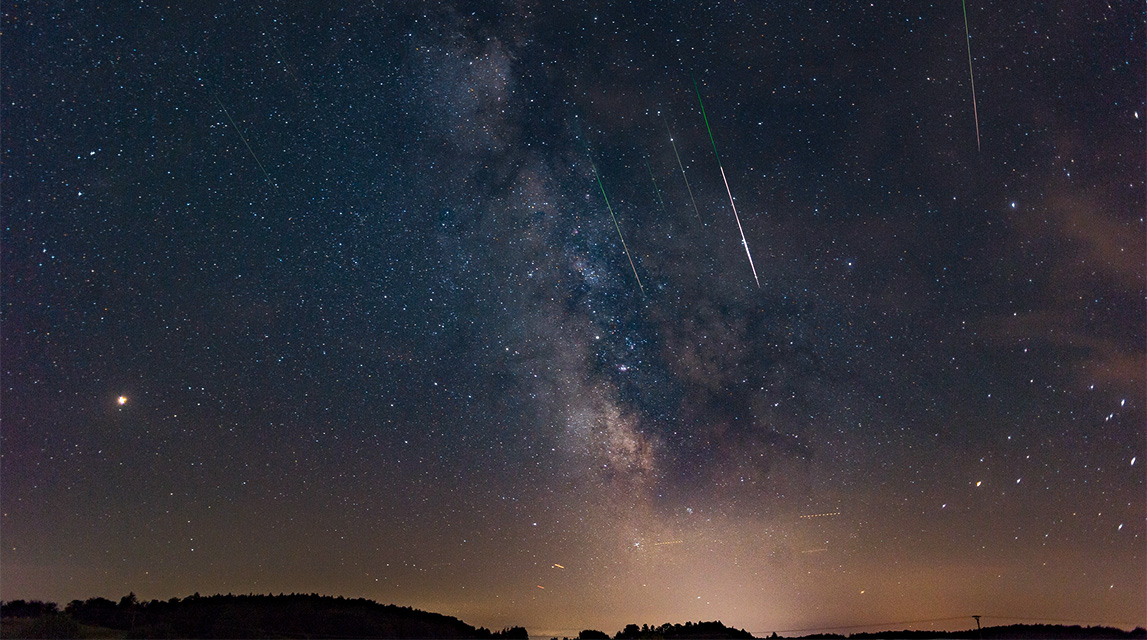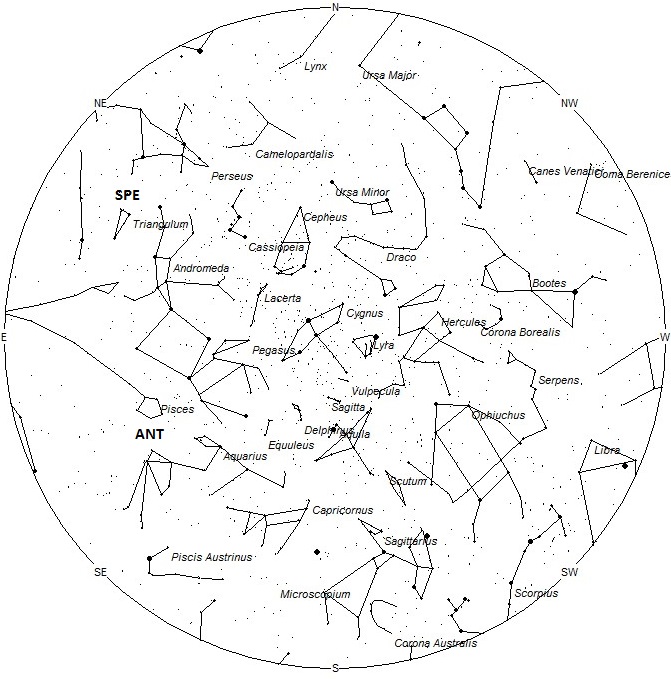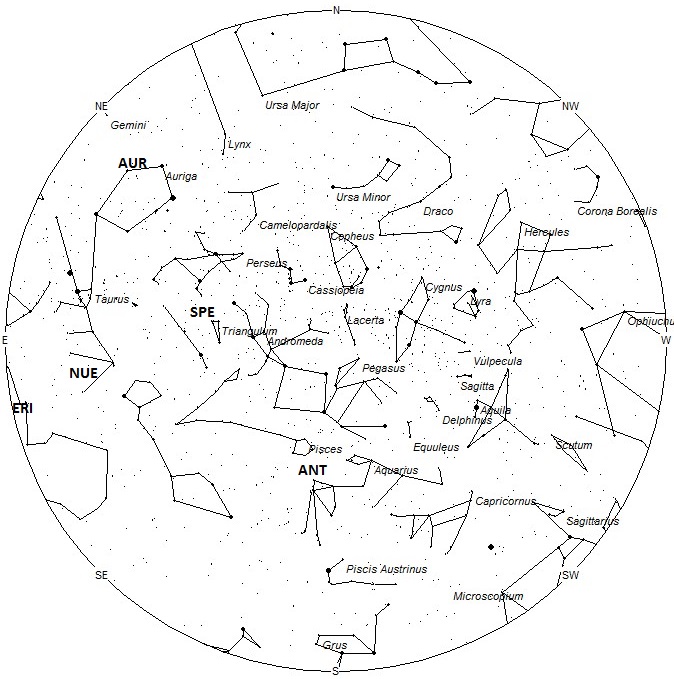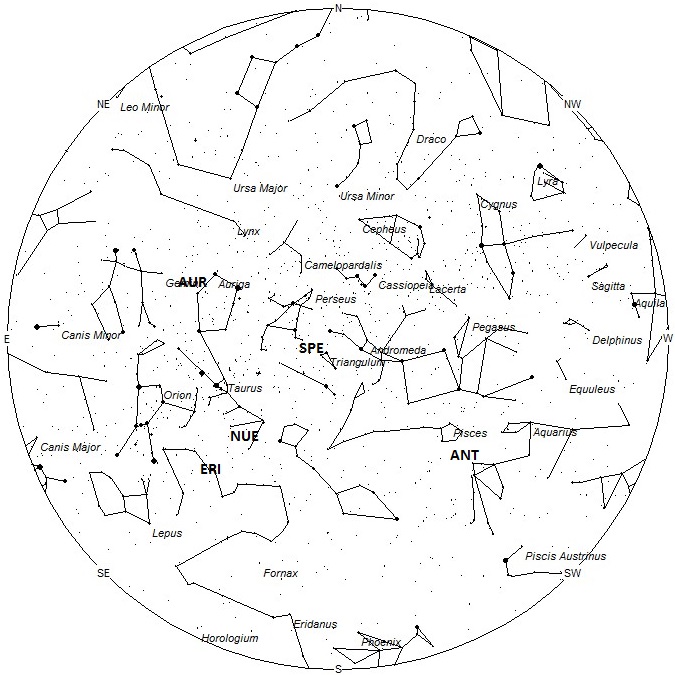
Nikon Df, ƒ/2.8, 28.0 mm, ISO1000
September offers longer nights in the northern hemisphere that tend to be less hazy than those experienced in mid-summer. In the sky, no major showers are visible from either hemisphere but the northern hemisphere enjoys the advantage of higher sporadic rates. Most of the shower activity this month is produced from the Perseus-Aurigid complex active this time of year. These showers rarely produce more than 5 meteors per hour but still manage to produce most of the shower activity seen this month. Unfortunately the Perseus-Aurigid complex lies too low in the northern sky for southern hemisphere observers to view very well. Video studies have shown that the Taurids are visible as early as September 23rd, therefore after this date the Anthelion radiant will no longer be listed until the Taurid showers end in December. The Anthelion meteors are still active but their radiant is superimposed upon that of the more numerous Taurids, therefore it is impossible to properly separate these meteors. Observers in the southern hemisphere suffer from some of their lowest rates of the year this month. The Taurid radiants are not too badly placed so observers south can expect to see a little of this activity from this source this month. Lastly, recent video data has shown that the Orionids are active during the last week of the month, often being the most active radiant in the sky even though their maximum is not until October 22nd.
During this period the moon will reach its last quarter phase on Monday September 3rd. At that time the moon will lie 90 degrees west of the sun in the sky and will rise near midnight local daylight saving time (LDT) as seen from mid-northern latitudes. As the week progresses the waning crescent moon will rise later with each passing night, creating more favorable viewing conditions. The estimated total hourly meteor rates for evening observers this week is near 4 as seen from mid-northern latitudes and also 3 for those viewing from subtropical southern latitudes (25S). For morning observers the estimated total hourly rates should be near 14 for those viewing from mid-northern latitudes and 9 for those viewing from subtropical southern latitudes (25S). The actual rates will also depend on factors such as personal light and motion perception, local weather conditions, alertness and experience in watching meteor activity. Morning rates are reduced during this period due to moonlight. Note that the hourly rates listed below are estimates as viewed from dark sky sites away from urban light sources. Observers viewing from urban areas will see less activity as only the brighter meteors will be visible from such locations.
The radiant (the area of the sky where meteors appear to shoot from) positions and rates listed below are exact for Saturday night/Sunday morning September 1/2. These positions do not change greatly day to day so the listed coordinates may be used during this entire period. Most star atlases (available at science stores and planetariums) will provide maps with grid lines of the celestial coordinates so that you may find out exactly where these positions are located in the sky. A planisphere or computer planetarium program is also useful in showing the sky at any time of night on any date of the year. Activity from each radiant is best seen when it is positioned highest in the sky, either due north or south along the meridian, depending on your latitude. It must be remembered that meteor activity is rarely seen at the radiant position. Rather they shoot outwards from the radiant so it is best to center your field of view so that the radiant lies near the edge and not the center. Viewing there will allow you to easily trace the path of each meteor back to the radiant (if it is a shower member) or in another direction if it is a sporadic. Meteor activity is not seen from radiants that are located far below the horizon. The positions below are listed in a west to east manner in order of right ascension (celestial longitude). The positions listed first are located further west therefore are accessible earlier in the night while those listed further down the list rise later in the night.
These sources of meteoric activity are expected to be active this week.
The center of the large Anthelion (ANT) radiant is currently located at 23:24 (351) -04. This position lies on the Aquarius/Pisces border , 4 degrees northeast of the 4th magnitude star known as phi Aquarii. Due to the large size of this radiant, Anthelion activity may also appear from western Pisces and northwestern Cetus as well as Aquarius. This radiant is best placed near 0200 LDT, when it lies on the meridian and is located highest in the sky. Hourly rates at this time should be near 2 no matter your location. With an entry velocity of 30 km/sec., the average Anthelion meteor would be of medium-slow velocity.
The first of the September Epsilon Perseids (SPE) should be seen this week. This stream is active from September 3 through October 3 with the peak occurring on September 11th. The radiant is currently located at 02:33 (038) +37. This position lies in northeastern Triangulum, 4 degrees northeast of the 4th magnitude star known as gamma Trianguli. The radiant is best placed near 0500 LDT, when it lies highest above the horizon. Rates are expected to be less than 1 no matter your location. With an entry velocity of 65 km/sec., most activity from this radiant would be swift.
The nu Eridanids (NUE) were co-discovered by Japanese observers using SonotoCo and Juergen Rendtel and Sirko Molau of the IMO. Activity from this long-period stream stretches from August 24 all the way to November 16. Maximum activity occurs on September 8th. The radiant currently lies at 03:45 (055) +02, which places it in southwestern Taurus, 4 degrees southwest of the 4th magnitude star known as nu Tauri. This area of the sky is best seen during the last dark hour before dawn when the radiant lies highest in a dark sky. Current rates are expected to be near 1 per hour during this period no matter your location. With an entry velocity of 67 km/sec., the average meteor from this source would be of swift velocity.
The eta Eridanids (ERI) were discovered by Japanese observers back in 2001. Activity from this stream is seen from July 23 though September 17 with maximum activity occurring on August 11. The radiant currently lies at 04:12 (063) -06, which places it in northern Eridanus just west the spot occupied by the 4th magnitude star known as Beid (Omicron1 Eridani). This area of the sky is best seen during the last dark hour before dawn when the radiant lies highest in a dark sky. Current rates are expected to be less than 1 per hour during this period no matter your location. With an entry velocity of 65 km/sec., the average meteor from this source would be of swift velocity.
The Aurigids (AUR) are currently active from a radiant located at 06:08 (092) +39, which places it in eastern Auriga, 3 degrees northeast of the 3rd magnitude star known as theta Aurigae. This area of the sky is best seen during the last dark hour before dawn when the radiant lies highest in a dark sky. Current rates are expected to be near 1 per hour as seen fro the northern hemisphere and less than 1 as seen from south of the equator. With an entry velocity of 67 km/sec., the average meteor from this source would be of swift velocity.
The Daytime zeta Cancrids (ZCA) were discovered back in 1964 by C.S. Nilsson in a southern hemisphere radio survey of meteor streams. This stream is active from August 13 through September 10 with maximum activity occurring on September 3rd. The radiant is currently located at 09:00 (135) +12, which places it in southeastern Cancer, very close to the spot occupied by the 4th magnitude star known as Acubens (alpha Cancri). This area of the sky is located only 30 degrees west of the sun so any possibility of seeing these meteors would be limited to the time just before the start of morning twilight. Current rates are expected to be less 1 per hour no matter your location. With an entry velocity of 42 km/sec., the average meteor from this source would be of medium velocity.
As seen from the mid-northern hemisphere (45N) one would expect to see approximately 10 sporadic meteors per hour during the last hour before dawn as seen from rural observing sites. Evening rates would be near 3 per hour. As seen from the tropical southern latitudes (25S), morning rates would be near 6 per hour as seen from rural observing sites and 2 per hour during the evening hours. Locations between these two extremes would see activity between the listed figures. Morning rates are reduced during this period due to moonlight.
The list below offers the information from above in tabular form. Rates and positions are exact for Saturday night/Sunday morning except where noted in the shower descriptions.
| SHOWER | DATE OF MAXIMUM ACTIVITY | CELESTIAL POSITION | ENTRY VELOCITY | CULMINATION | HOURLY RATE | CLASS |
| RA (RA in Deg.) DEC | Km/Sec | Local Daylight Saving Time | North-South | |||
| Anthelions (ANT) | – | 23:24 (351) -04 | 30 | 02:00 | 2 – 2 | II |
| September Epsilon Perseids (SPE) | Sep 11 | 02:33 (038) +37 | 65 | 06:00 | <1 – <1 | II |
| nu Eridanids (NUE) | Sep 08 | 03:45 (055) +02 | 67 | 07:00 | 1 – 1 | IV |
| eta Eridanids (ERI) | Aug 11 | 04:12 (063) -06 | 65 | 07:00 | <1 – <1 | IV |
| Aurigids (AUR) | Sep 01 | 06:12 (093) +39 | 67 | 09:00 | 1 – <1 | II |
| Daytime zeta Cancrids (ZCA) | Sep 03 | 09:00 (135) +12 | 42 | 12:00 | <1 – <1 | IV |
 American Meteor Society
American Meteor Society



Hi Robert, I was sitting outside in Henderson, Ky 9-01-18 and over the course of the night observed at least 8 falling stars. Mostly facing NW but I eventually saw one in almost every direction by the time it was getting light out. Two of the times it was directly through the two stars that make up Cepheus’ head. I’d only seen shooting stars a handful of times before so it was pretty exciting for me:)
I saw a bright fireball slide across the sky towards the east, early morning of Thursday August 30th in Florida. It stayed visible long enough to call attention to the person I was with. Meteorite? Space junk? It was so cool! I didn’t hear about it anywhere else though.
We saw a fireball at 10pm tonight September 6th in central Florida Avon Park. It was moving north to south. Bright red and slow. It broke up into several pieces as it entered the atmosphere
Hi Robert, slept outside last night, 9/9/18, in northern Colorado and was surprisingly thrilled to observe 6 meteorites within a 15 minute time span around 3 am. Had a clear view of the southern sky. Can’t definitively determine what shower those were part of. Can you help? Maureen
Hi Maureen and All,
Chances are most of the meteors you witnessed were sporadic, random meteors that cannot be associated with any known shower. That night is close to the peak of the September epsilon Perseids so 1 of them could possibly be a member of that shower. It’s impossible for me to be precise using just your counts. That is why we need observers to determine for themselves shower association. Hopefully the star charts included in each meteor activity outlook can help as shower meteors shoot outward from the locations indicated on the chart.